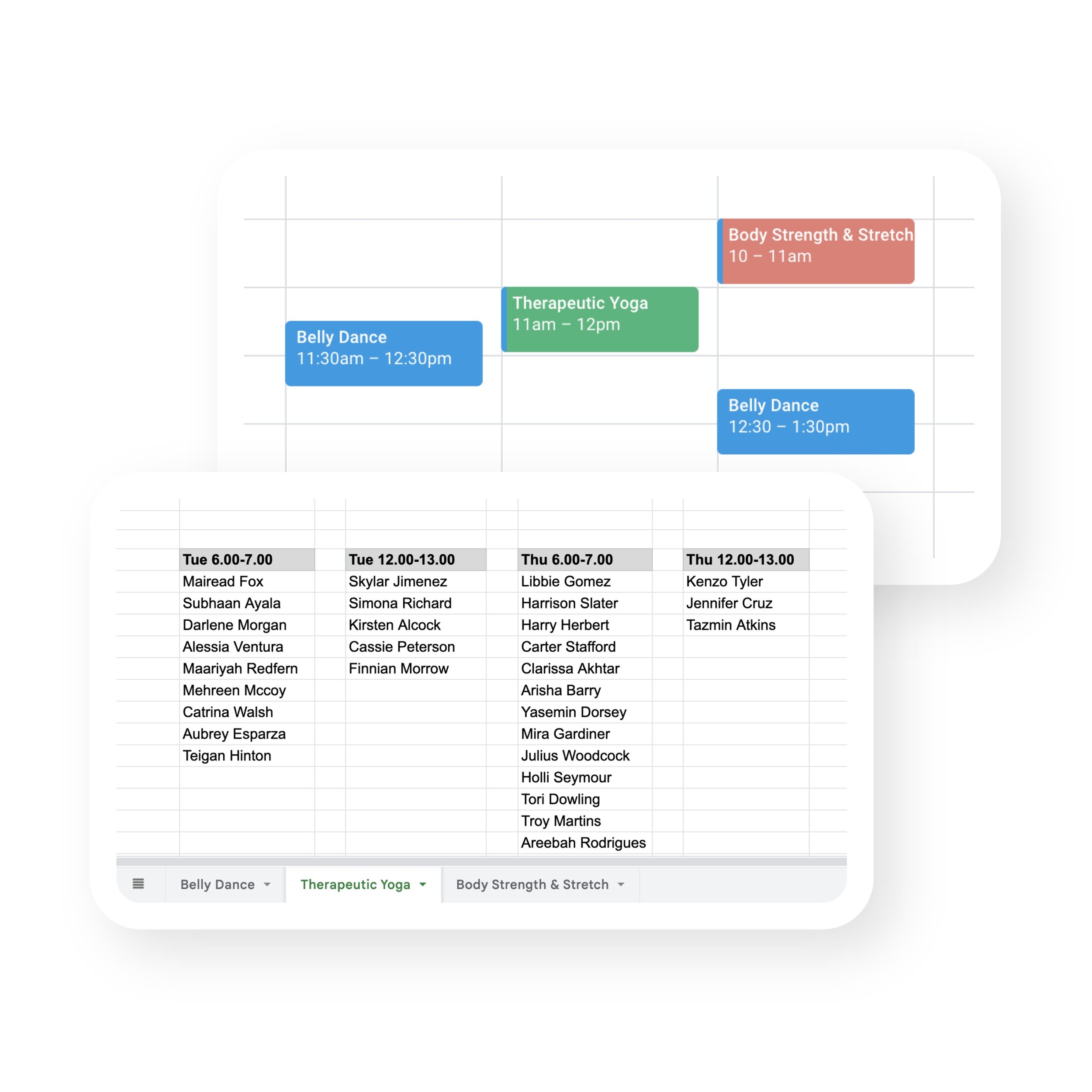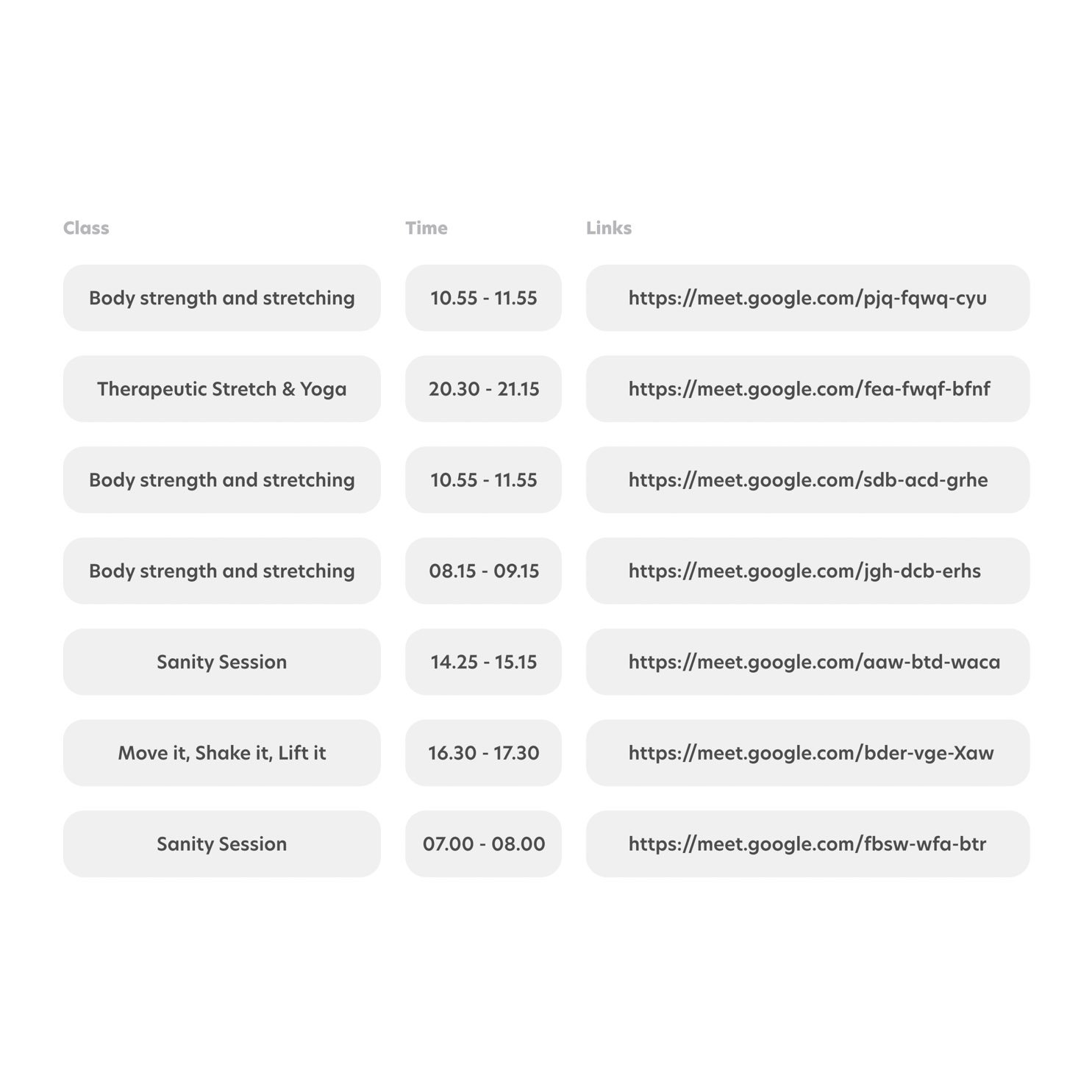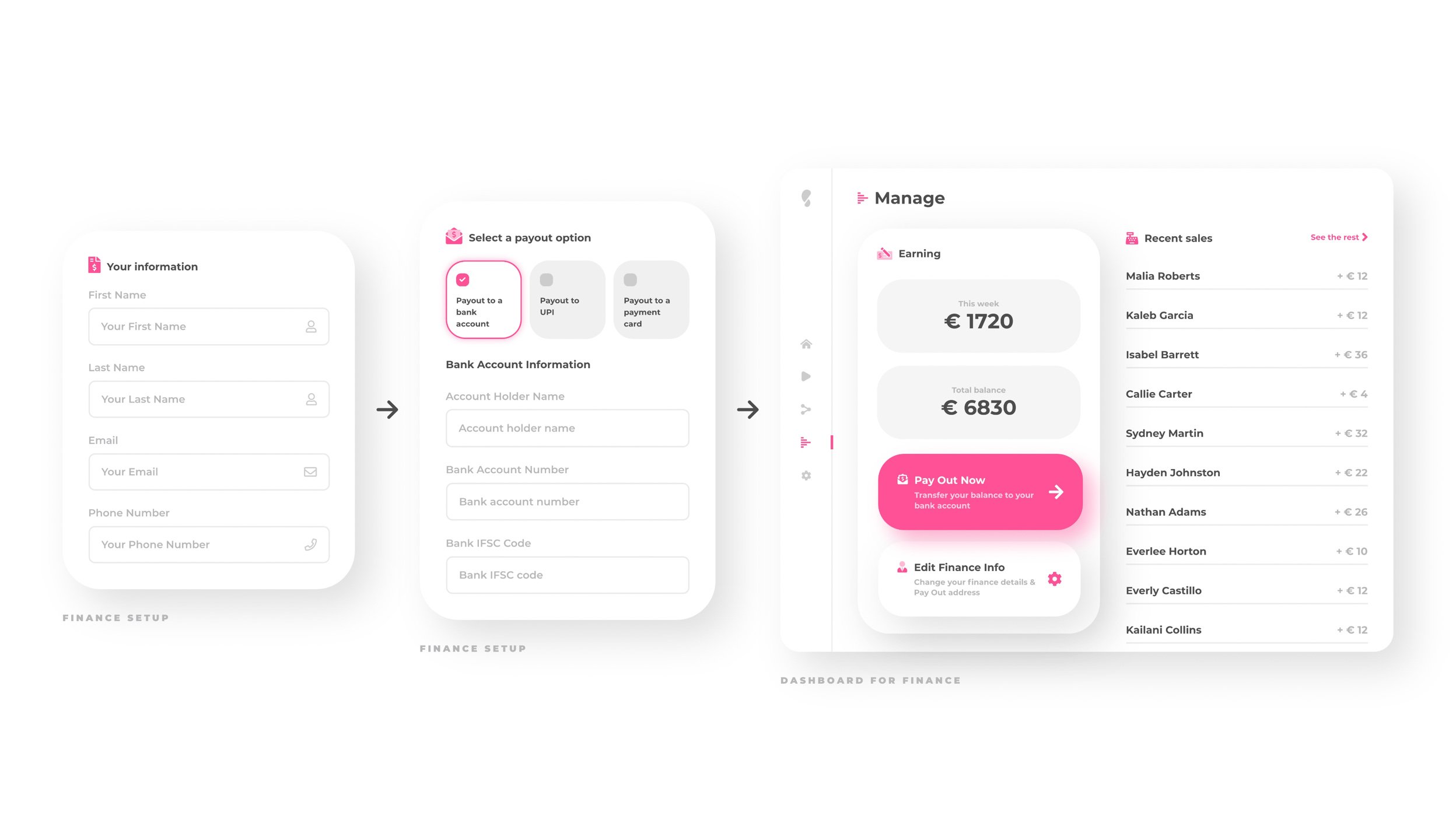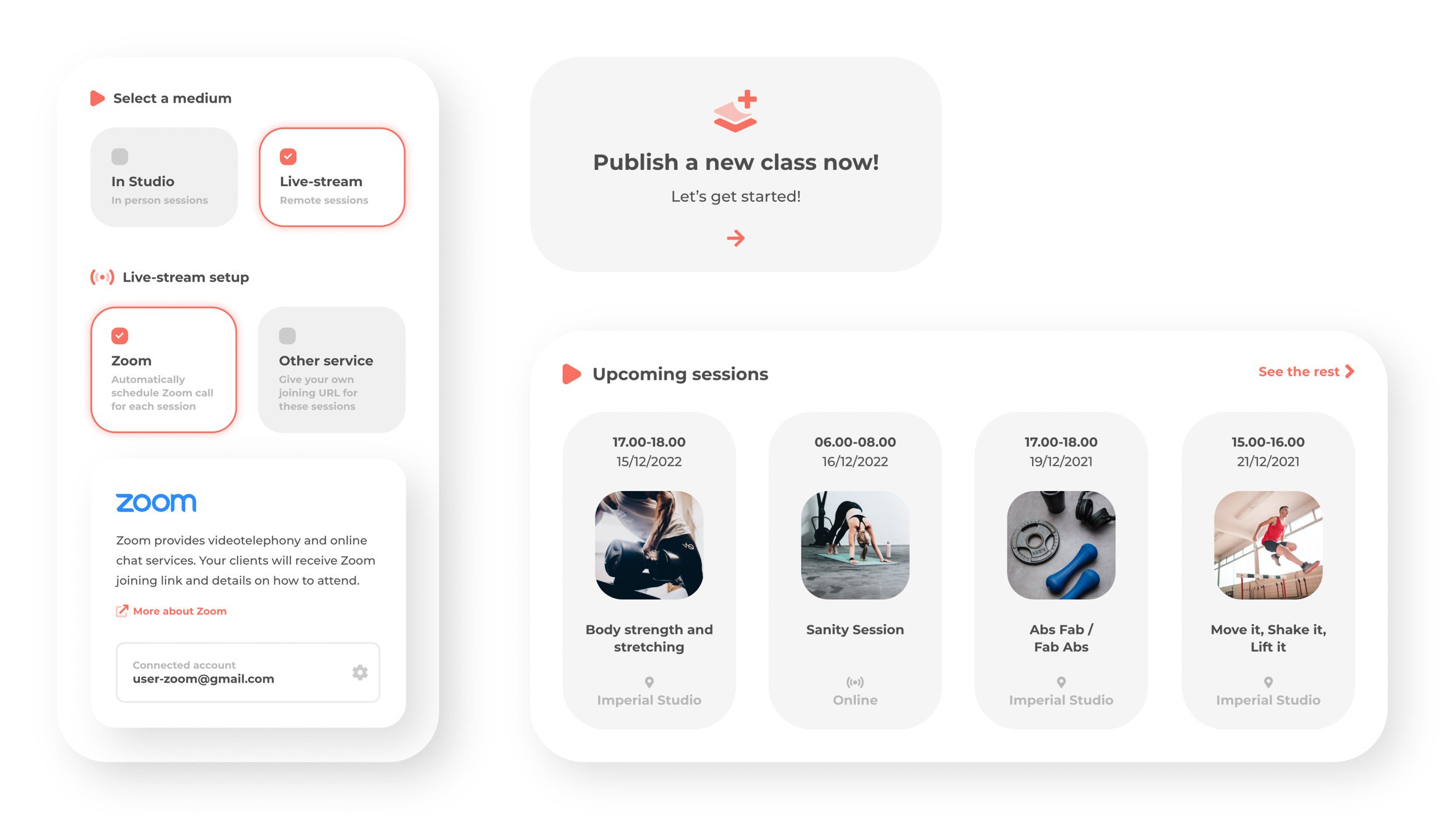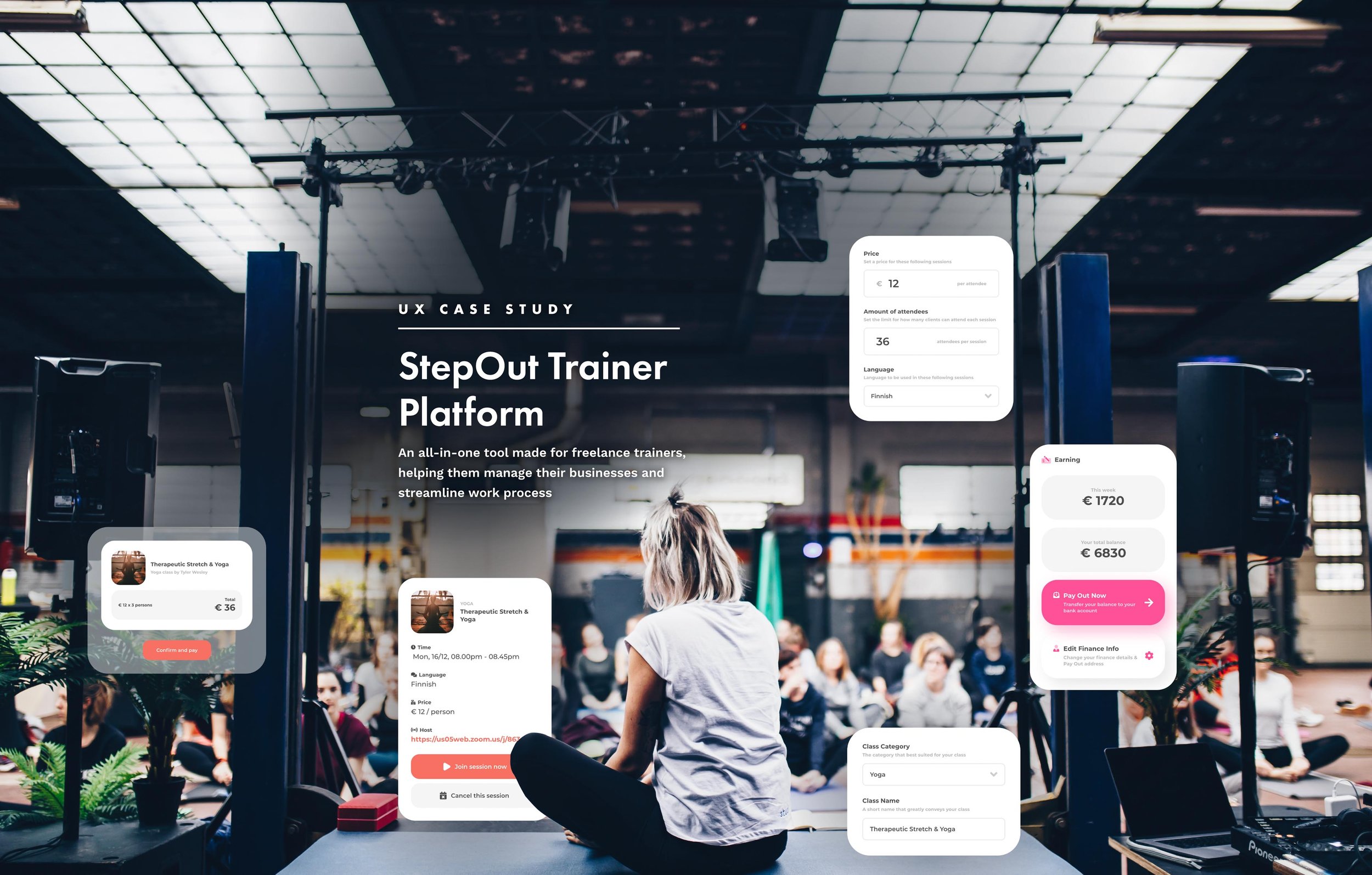
The problem
In the Fitness & Wellness industry, the market segment for Freelance Fitness Trainers is growing rapidly. However, unlike fitness entities, when working as a freelancer, one has to take care of every single task themself. Indeed they are experts in their respective fitness professions, but not everyone has expertise in financial management, sales or marketing.
Freelance trainers have to make do by utilizing multiple apps.
Classes information are presented through social media such as Instagram posts.
There is no touchpoint for clients to browse the classes, no call-to-action to book, and no proper user flow to checkout.
To book a spot, clients need to send trainers a DM, or fill in a Google form. The only way to check if a particular session is fully booked is to ask the trainers directly, again via DMs.
Payments are made using money transfer services like Venmo, Revolut or MobilePay, those services that we normally would use for splitting a dinner bill between friends or something.
Even worse, bookings management and classes scheduling are done manually by the likes of Google Calendar and Google Sheets.
Of course there are existing tools & platforms out there that are assisting fitness businesses. However, in most cases, they were purposely made for medium / big fitness entities and gyms, and not really suitable for independent, freelancing trainers.
Furthermore, most of them are very confusing for amateurs to understand and use, and would require users to have knowledge in business management beforehand.
Our Solution
We took this opportunity to build StepOut: an all-in-one tool that focused in helping freelance trainers to take care of every aspects of their businesses. The tool lets trainers put up a website of their own, publish classes, take bookings and receive payments from clients.
So for the next few months, we went from these core objectives to the first beta release for public users.
My Role
My primary role was Product Designing, but I also lead on the branding, web design, as well as assisting in producing contents for marketing.
Team
2 co-founders, 3 engineers, 2 marketers & 1 designer
Timeline
November 2021 - April 2022
Tools
Adobe XD, Overflow, Illustrator & Photoshop
Publish your classes
Setup up your classes and build up a schedule for yourself. Host the sessions in either live-streaming, or at a studio!
Setup your finance details
All your earnings from your classes will be paid out to you on the details that you provide here.
Build your Trainer Profile
In the matter of minutes, you can setup your very own web-store, where your clients can learn more about you, browse your classes, as well as reach out to you directly!
Share your classes, reach your clients, and get to work!
Social media posts, stories, reels, messages, blogs, … Your classes are now reachable from anywhere. Take bookings from clients, manage sessions, and get to work!
Competitive Analysis
We researched into the market to see whether existing tools & platforms can help trainers streamline their workflow. Here’s our findings:
Mindbody and Glofox were 2 BMS that specifically made for managing fitness businesses, however:
Both of these 2 are targeting to serve medium to large fitness entities, such as gyms, studios or franchises
They are complex, not user friendly, with many features meant for business management
Pricing is also too high for a freelancer’s budget
Freelance / solo trainers can view Fittr as a possible solution, but they actually employ trainers to become their own in-house coaches. This means:
Fittr required to applicants to hold certain industry accepted certifications, and has to went through a probation / testing process (similar to a job interview process). And they will be employed by Fittr only when they cleared all these steps.
Trainers would have to abide by certain guidelines from Fittr, which may or may not hamstring their creativity / teaching freedom
Airbnb Experiences lets people host activities such as fitness / recreational classes, cooking sessions, tour guides, …
Out of the 4 competitors we studied, we think Airbnb Experiences gives the best UX, for both clients and hosts. UIs looks clean, easy to understand and intuitive to use.
However, this platform is directed towards tourism clients, which means hosts don’t expect recurring clients as typical trainers do. This is reflected in their customer journey, as it’s tailored for one-time purchases.
Also, in order to host an activity on Airbnb Experiences, hosts must meets all the standards set by Airbnb, and went through a very thorough reviewing process from them (which will take time and effort to accommodate).
Understanding the problem
At StepOut, we have built and continuing to grow a community of freelance trainers and fitness / recreation lovers alike. Although the idea came to us from many of our close contacts, we determined that validating the problem must be done properly.
Therefore we decided to conduct a larger user interviews, consisted of trainers both from and not from our network, and also a few trainers from other countries too. We even included some freelancers from other industries, so we can have as broad of a view as possible into the problem.
Here are what we’ve found out:
There isn’t a streamline workflow for a freelance trainer
There is an app for almost any task, but one single app that can do all the tasks that a freelance trainer need just simple isn’t available.
Error-prone & inefficient to manage
As trainers have to utilize multiple apps, their data and workflow are shared across these apps, and unfortunately not every app has integration with another one (in most cases they don’t). Manage bookings & payments, organize & keep track of data, are all extremely inefficient and difficult.
Organizing online classes is complicated
Trainers had to manually scheduling sessions in services like Zoom, and kept track of the joining links for each sessions.
BMS tools are expensive and hard to use
Business management system (BMS) are the most suitable tools for managing fitness business, but their targeting users are medium to large entities / organizations, not individual freelance trainers. These tools offer far more features than what the trainers can think of using, and its userflow aren’t really great, if not confusing. And also, they are too expensive for freelancers’ budget.
We condensed our findings into this persona below, that represents our targeting users. This gives us a focused and clear view of who our product tried to solve problems for:
We concluded the researching phase by framing the design challenge using point-of-view (POV Madlib), and then defined the problem statement.
User: A full-time freelance trainer
Need: To find a tool that can handle all the work of hosting and managing training sessions
Insight: The trainer has to use in combination of many different tools to handle the work, which decreases efficiency, causes confusion and misplacement of information.
Problem Statement
A freelance trainer needs to find a single platform that can handle all the work of hosting and managing training sessions because he wants to improve efficiency and minimize errors.
Based on these, we generated some How Might We questions to help guiding the ideation:
How might we (HMW) publish and scheduling training sessions in the most effortless way?
HMW minimize confusion in the process of managing sessions?
HMW host online training sessions more efficiently?
HMW handle clients' payment better?
HMW book venues for on-site training sessions?
HMW predict the amount of clients per session?
HMW present sales statistics better?
HMW help clients find more relatable classes?
HMW help clients find more relatable trainers?
Defining the MVP
The sky is the limit, and there are so many things we wanted to achieve with StepOut. But first, we need to set some goals for the MVP: what would success in this first release looks like? Here is what we decided:
Trainers have their own personalized web-store to promote themselves and their classes
Give trainers a quick & easy way to publish and sell their classes
Trainers can effortlessly manage and teach classes
Iterate closely with trainers
Features prioritization
To accomplish those goals, we prioritized the following 5 primary features:
FEATURE #1
Setting up Trainer Profile page
Publishing a new class
FEATURE #2
Booking & paying for a spot at a class
FEATURE #3
Attending an online class
FEATURE #4
Receive earnings from selling classes
FEATURE #5
The Designs
As we were designing StepOut from the ground-up, our design system started simple, and stayed flexible as we went on.
I was the sole designer of the founding team. Therefore, in addition to being a Product Designer, I also took part in the marketing side.
I produced pitch decks and promotion videos to present our products and its values to potential users.
First things first, there are only 2 initial setup steps that we would need our users to do, before they could start using StepOut:
We begin by setting up user Finance Details, as this is probably the most problematic setup of all, so we thought it’d be best to have that out of the way asap.
INITIAL SETUP 1 / 2
After that, users will setup their Profile Page. This will be their own personalized web-store, to introduce themselves, and present their classes.
INITIAL SETUP 2 / 2
With these 2 things in place, users can start create, sell and teach classes right away!
We tried to keep the UIs as minimal as possible. Limited call-to-action per screen (usually max of 2 CTAs), no excess details, no just-for-the-visual components, every feature and its user flow is designed to be as neat and as quick as possible.
We determined StepOut is a tool made for helping trainers manage their businesses more efficiently, therefore, the quicker trainers can do things using StepOut, the better. Or in other words:
The less time the trainers needed to interact the app, the more valuable StepOut will be to them!
We organized features of this product neatly into 3 main sections, focusing into the 3 core functions that trainers need:
The ability to teach
The ability to promote their business
The ability to manage finance for their business
Each section will be associated with its own signature color and icon, and will be color-coded throughout the UIs. We hope that by doing this, users would find things much quicker and easier.
Teach
Publishing, teaching and managing classes
As the name suggested (and hopefully the ‘play’ icon helps as well), all things related to teaching can be found here, such as manage classes, schedule new sessions within classes, etc..
Orange has been StepOut branding color for a while now, and for this product, we decided to associate it with Teach, as teaching features are the closest to the trainers’ professions.
Reach
Assisting in marketing and exposure
Features that we have planned for Reach are beyond the scopes of our first MVP. However we decided to allocate a space for them and do the color-coding work already. Reach are the set of features to help trainers analyze and understand their marketing/sales performance, generate actionable insights and help them grow!
We figured the blue color, which was usually associated with social media platforms, would be suitable.
Manage
Handles everything regarding the financial side
All financial matters can be found in Manage, such as Earnings Overview, request a Pay Out, manage Trainer’s expenses, …
The pink color may not necessarily be the most obvious choice for finance theme, but we really like this color, and found that it fits the tone very well!
Insights & Iterations
We collect data and insights through 3 channels:
Feedback form inside the app
Data collected by our developers
Bugs report page in Notion
We conducted user testings at every stage of the development, because the sooner we identified a pain point, the cheaper and faster it is to iterate. We would constantly revisit the prototypes and re-tested new iterations, as early as at lo-fi prototyping stage.
Here’s a few examples of iterations that made it to production:
One surprisingly simple thing that many trainers pointed out: they would prefer Profile Setup to be the first step, as this is one of the fundamental reasons why they signed up.
Also, apparently people would prefer doing the easier step first.
Conference Call Service integration, also a highly requested feature during the beta. As the result of COVID, many trainers could only be able to host classes remotely, using Zoom, Google Meet or a similar (and user-friendly conferencing call service).
We spent quite some time and resources to implement a direct Zoom Account connection function, so that with a single click, trainers can now schedule sessions, and a Zoom session will be created automatically, and its joining link will be sent to the clients after they booked a spot.
And to be more flexible, we also give an option to input a joining link of any other service, such as a Google Meet joining link.
A few trainers told us that at some point during the customer journey, they didn’t actually know what to do next.
So we created some additional CTA cards to help guiding trainers to move forward.
Personal Takeaways
Working in an early-stage startup such as StepOut has taught me a lot. A startup means resources are super limited, and also means things are in a bit of a hurry. It taught me to work really efficiently, to spend time and resources precisely where and when is needed the most.
Here’re some personal takeaways for me from this project:
Rapid prototyping - rapid testing
Prototyping quickly and cheaply (hand-drawn lo-fi) so that you don’t get emotionally attach to the designs, in order to receive constructive / honest feedbacks. Then when you get new insights and ideas, get back to the design board and reiterate your designs asap.
Test, test, test and test
Constant and repeatedly conducting user testing at every stage, so that you can validate the designs. It may takes a hundred iterations before only one made it to production, but that last one would actually be valuable to the customers. Remember that at the end of the day, you are trying to solve your users’ pains.
Don’t worry too much about the look
With background in graphic design, I was (and actually am still) care a lot for the visual aspect of the UI. However, working in a startup has taught me that resources are limited, and we sometimes need to compromise visual for functional. Put user experiences first!




